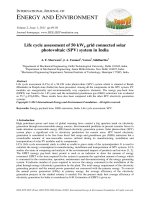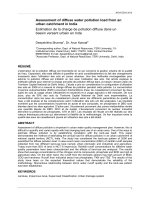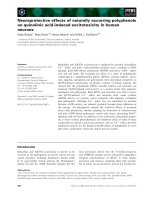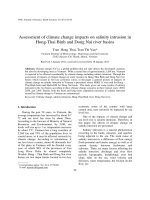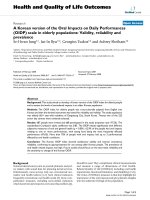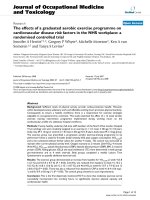Assessment of infant care practices and effectiveness of structured teaching programme on 3-6 month infant care in a selected ward in Malappuram, India
Bạn đang xem bản rút gọn của tài liệu. Xem và tải ngay bản đầy đủ của tài liệu tại đây (240.38 KB, 7 trang )
Int.J.Curr.Microbiol.App.Sci (2019) 8(3): 1949-1955
International Journal of Current Microbiology and Applied Sciences
ISSN: 2319-7706 Volume 8 Number 03 (2019)
Journal homepage:
Original Research Article
/>
Assessment of Infant Care Practices and Effectiveness of Structured
Teaching Programme on 3-6 Month Infant Care in a Selected Ward in
Malappuram, India
M. Rathi*
Almas College of Nursing, Kottakkal, Malappuram, Kerala, Pin:-676503, India
*Corresponding author
ABSTRACT
Keywords
Infant care practice,
Effectiveness,
Structured teaching
programme,
Structured interview
schedule
Article Info
Accepted:
15 January 2019
Available Online:
10 February 2019
Infancy is a critical period in the life of every individual owing to the various adjustments
that need to be made for extra uterine survival. Therefore, mortality rates are also very
high in this one year period. Good care practices go a long way in reducing morbidity and
mortality in this period. A cross sectional study was undertaken on a cohort group of
mothers with 3 month old infants to assess their care practices and to determine the
effectiveness of a structured teaching programme on good infant care in ward No. 3 of
Ponmala Panchayath in Malappuram. Objectives of the study are to assess the infant care
practices & to determine the effectiveness of a structured teaching programme on Good
infant care to mothers with 3 month old infants. A total of all available mothers with 3
month old infants (16 Nos.) in the mentioned ward were included in the study. A
structured interview schedule was used to assess care practices. After pretest, STP on good
infant care was provided. After a period of one week, post test data was collected.
Significant desirable practices identified were nonuse of prelacteals (except Mecca Water)
and exclusive breast feeding. Significant undesirable practices identified included
improper breast feeding technique, use of cradles for night time sleep and use of cold
water for infant bath. T test was used to assess effectiveness of STP and it was significant
at 0.05 level. This study revealed the prevailing infant care practices and the need for
sustained education on infant care.
Introduction
According to a Report by UNICEF, India has
experienced gain towards the fight against
infant mortality rates in the country over the
last two decades. However, the latest trend
does not show the ability of the country in
achieving the Millennium Development Goal
No.4 which aims at reducing the under-five
mortality by two thirds in the period
stretching1900 to 2015 (1,2). Despite the
progress, IMR in India is very high. It is
estimated that about 400,000 newborns in
India die within the first 24 hours of birth.
IMR in India varies from state to state. In
India, Kerala, Tamilnadu, Maharashtra,
Punjab, West Bengal and Himachal Pradesh
are registering significant improvements in
infant mortality rates (3,4).
1949
Int.J.Curr.Microbiol.App.Sci (2019) 8(3): 1949-1955
Infant health depends to a large extent on the
antenatal and neonatal care received and to a
considerable extent on the infant care
practices adopted at home: Practices including
those on food hygiene, feeding, bathing and
comfort, safety and emergency management,
play and stimulation are considered as vital
components to the healthy growth and
development of infants. This study sought to
study the prevailing infant care practices in
Malappuram District of Kerala.
and development, common health problems in
infants major disease conditions and
management and other conditions all relating
to good infant care were utilized for the study.
Treatment: Conduction of STP on good infant
care.
The main objectives of this study to assess the
existing infant care practices prevailing in the
selected community. Identification of existing
practices for selected infant ailments. And
also to assess effectiveness of Structured
Teaching Programme on good infant care.
Procedure: With the help of local anganwadi
teachers, the houses of the mothers were
identified. A total of 3 mothers were
interviewed in a day. After assessing their
infant care practices including those for
selected ailments, the pretest questionnaire
was dictated to them and their choices
recorded. Then the STP was administered
using the growth chart and videos on infant
care. After a week by which all the mothers
had been covered for pretest, post test was
conducted in the same order.
Materials and Methods
Setting and Subjects: Descriptive research
design was used for assessing existing infant
care practices using structured interview
technique. A pre-experimental approach with
one group pretest-posttest design was utilized
for assessing effectiveness of STP. A total of
16 mothers who were the only ones available
with 3 month old infants in the selected ward
of Ponmalapanchayath in Malappuram district
were the samples selected by purposive
sampling technique.
Tools: In addition to the Sociodemographic
data collection tool on mother and infant, a
structured interview schedule having five
sections related to infant care was used to
assess infant care practices namely hygiene
practices, comfort practices, feeding practices,
safety practices and play and stimulation, an
open ended questionnaire for assessing care
practices for selected infant ailments and a
structured close ended questionnaire with 20
questions under six areas namely growth and
development
parameter,
developmental
characteristics, deviation from normal growth
Validity: To ensure content validity, the tool
was submitted to experts in the field of
pediatrics, pediatric nursing and community
health.
The collected data was analysed using
descriptive and inferential statistics (Table 6).
Results and Discussion
The sample characteristics are given in Table
1 and 2.
Table 1 shows that 63% of the samples were
aged 18-25 years, 100% were Muslims and
56% had higher secondary education. 94%
were housewives and all 100% had
institutional delivery. Only 12% had caesarian
section done. 13% mothers had retracted
nipple and 44% of the neonates had jaundice
in their first month.
Table 2 shows significant findings such as
81% infants with birth weight of more than
2500gms., 0% preterm babies, 12% infants
with birth order of four or more, space
1950
Int.J.Curr.Microbiol.App.Sci (2019) 8(3): 1949-1955
between children more than 2 years in 75%
infants, 100% hospital visits for infants with
sickness, 81% immunized appropriately for
age, 88% living in extended families and 69%
families using well water for home and infant
use.
Table 3 gives an insight into the practices
adopted for common infant ailments. As is
seen from the table, majority of the mothers
chose to go for homeopathic treatment for the
infants since they believed that homeopathic
medicines are mild and have no side effects.
Tulasi is also found to be predominantly used
in the homes for treating fever and cold.
Table 4 highlights significant lapses in infant
care that can prove dangerous for infant
survival. It also points out the need for
sustained health education to the mothers on
infant care. Considering that only 25% of the
mothers were primipara, the findings gain
more significance. The findings also depict a
stereotyped mode of care prevailing in the
locality. Mothers who bathed infants in cold
water opined that well water was fresh and
would strengthen the baby. Similarly putting
baby in the cradle is thought to promote good
sleep and the danger of suffocation and falls
go unnoticed.
Table 5 shows the difference in pre and post
test scores on administration of the STP. The
findings reflect the ability of the mothers in
understanding the information provided to
them.87% mothers obtained good knowledge
in the post test.
Table.1 Demographic characteristics of mother
N=16
Sl.
No:
i
ii
iii
iv
Demographic Characteristics
Frequency
Age
a) Less than 18 yrs.
b) 18-25 yrs.
c) 25-35 yrs.
d) Above 25 yrs.
Religion
a) Hindu
b) Christian
c) Muslim
d) Others
Level of Education
a) Nil
b) Primary
c) High school
d) Higher secondary
e) Graduation & above
Family income per month
a) Less than Rs. 1500/b) Rs. 1500/- to Rs. 3000/c) Rs.3000/- to Rs 9000/d) Rs 9000/- to Rs 15000/-
10
6
16
-
1951
%
63
37
100
5
9
2
31
56
13
2
5
6
3
13
31
38
19
Int.J.Curr.Microbiol.App.Sci (2019) 8(3): 1949-1955
v
vi
vii
viii
ix
x
xi
xii
xiii
xiv
xv
e) Greater than Rs 15000/Occupation
a) Housewife
b) Informal work
c) Laborer on wages
d) Business / Self Employed
e) Any other
Antenatal checkups
a) Regular
b) Irregular
Antenatal period
a) Eventful
b) Uneventful
-
Place of delivery
a) Home
b) Hospital
c) Others
Nature of delivery
a) Normal
b) Caesarian
c) Others
Intradelivery problem
a) Yes
b) No
Problem in breast feeding
a) Yes
b) No
Breast feeding
a) Not established at all
b)Stopped before 3 month
c) Ongoing
Problem in neonatal period
a) Yes
b) No
Chronically ill parent
a) Yes
b) No
Alcoholic parent
a) Yes
b) No
1952
15
1
-
94
6
16
-
100
-
4
12
25
75
16
-
100
14
2
-
88
13
-
2
14
13
88
2
14
13
88
16
100
7
9
44
56
1
15
6
94
16
100
Int.J.Curr.Microbiol.App.Sci (2019) 8(3): 1949-1955
Table.2 Demographic Characteristics of Infant
Sl No:
i
ii
iii
iv
v
vi
vii
viii
ix
x
xi
Demographic Characteristics
Sex
a) Male
b) Female
Birth Weight
a) Less than 1500gm
b) 1500gm - 2500gm
c) Greater than 2500gm
Gestational age
a) Preterm
b)Term
c)Post term
Birth order
A) First child
B) Second child
C) Third child
D) Fourth And above
Age of previous child
a) 1- 2 years
b) More than 1-2 years
Hospital visit for sickness
a) Yes
b) No
Immunized appropriately for age
a) Yes
b) No
Type of family
a) Nuclear
b) Extended
c) Single
Type of house
a) Single
b) Colony
Power supply
a) Electricity
b) Solar
c) Nil
Water Supply
a.
Protected supply
b.
Well water / Spring
c.
Stream / River water
d.
Pond / Lake
e.
Others
1953
Frequency
N = 16
%
8
8
50
50
3
13
19
81
16
-
100
4
6
4
2
25
38
25
12
4
12
25
75
16
-
100
13
3
81
19
2
14
-
12
88
16
-
100
16
-
100
11
5
69
31
Int.J.Curr.Microbiol.App.Sci (2019) 8(3): 1949-1955
Table.3 Care practices on infant ailments
SlNo:
Infant Ailments
i
Fever
a) Thulasi
b) Homeopathy
c) Allopathy
d) Panikoorka
e) cold application
ii
Diarrhea
a) Homeopathy
b) Allopathy
c)Conjee
d) Lime & salt
e)Panikoorka
iii
Common cold
a) Homeopathy
b)Thulasi
c) Allopathy
d) Vayambu&Masikka
iv
Abdominal colic
a) Homeopathy
b) Allopathy
c) Palkayam
v
Constipation
a) Homeopathy
b) Allopathy
c)Soaked dry grapes
d)Brahmi juice
Frequency
7
5
3
1
2
8
4
1
1
2
9
5
2
1
10
5
1
9
5
2
1
Note: One respondent may give more than one option.
Table.4 Undesirable care practices identified
Sl No:
a
b
c
d
e
f
g
h
i
Practices
Frequency
Not covering head
Bathing infant in cold water
Putting baby to sleep in the cradle all night
Not observing infant all time
Ignorance of ORS
Ignorance of expulsion of foreign body from throat
Ignorance of prevention of milk aspiration
Ignorance on prevention and management of febrile fits
Ignorance of danger signs in infants
1954
15
12
16
12
16
15
16
11
14
%
94
75
100
75
100
94
100
69
88
Int.J.Curr.Microbiol.App.Sci (2019) 8(3): 1949-1955
Table.5 Difference in pre and post-test level of knowledge scores
Test
Pretest
Post-test
Good
14
87
Frequency
%
Frequency
%
Average
9
56
2
13
Poor
7
44
-
Table.6 Effectiveness of structured teaching programme
Knowledge Test
Pretest
Post test
Mean
9.37
16.87
SD
2.75
1.75
MD
7.5
CI
7.91-10.84
15.94-17.81
t value
10.19
P Value
<.05
t(15)≥ 2.131,P=0.05
The overall findings on infant care practices
indicate that they indeed play a major role in
mortality and morbidity of infant population
and need to be addressed in a concerned
manner.
References
In conclusion, assessment of infant care
practices is a vital need of the hour to strike
hard at infant morbidity and mortality at the
ground level. Health care professionals should
imperatively hold infant care practice
assessment and education as an essential
component of MCH care.
1. Rentala Sreevani (2019). Basics in
Nursing Research and Biostatistics.
New Delhi: Jaypee Brothers Medical
Publishers.
2. Votroubek Wendy, Aaron Tabaco
(2010) Pediatric Home Care for
Nurses.London: 3rd. Ed., Jones and
Barlett Publishers International.
3. www.socialresearchmethods.net
4. />
How to cite this article:
Rathi, M. 2019. Assessment of Infant Care Practices and Effectiveness of Structured Teaching
Programme on 3-6 Month Infant Care in a Selected Ward in Malappuram, India.
Int.J.Curr.Microbiol.App.Sci. 8(03): 1949-1955. doi: />
1955
